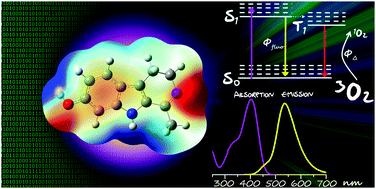Photophysical and spectroscopic features of 3,4-dihydro-β-carbolines: a combined experimental and theoretical approach†
Abstract
3,4-Dihydro-β-carbolines (DHβCs) are a set of endogenously synthesized alkaloids spread over a great variety of living species (e.g., plants, animals and microorganisms), playing a broad spectrum of biological, biochemical and/or pharmacological roles, in a structure-dependent manner. Addressing unresolved fundamental aspects related to the photophysical properties of DHβCs might help to gain further insights into the molecular basis of the mechanisms of the biological processes where these alkaloids are involved. In this work, the UV-visible spectroscopic features of DHβCs are revisited and they are further analyzed by calculations at the Density Functional Theory (DFT) level. In addition, steady-state and time-resolved fluorescence spectroscopy, as well as quantitative singlet oxygen production analysis is reported. Data obtained herein are discussed in the framework of the potential biological role of these alkaloids.



 Please wait while we load your content...
Please wait while we load your content...